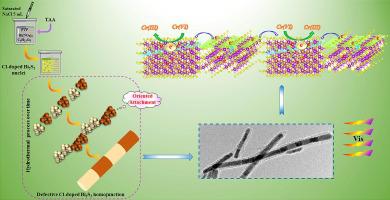当前位置:
X-MOL 学术
›
Appl. Surf. Sci.
›
论文详情
Our official English website, www.x-mol.net, welcomes your
feedback! (Note: you will need to create a separate account there.)
Cl-doped Bi2S3 Homojunction Nanorods with Rich-Defects for Collaboratively Boosting Photocatalytic Reduction Performance
Applied Surface Science ( IF 6.3 ) Pub Date : 2020-11-01 , DOI: 10.1016/j.apsusc.2020.147002 Lili Ai , Dianzeng Jia , Nannan Guo , Mengjiao Xu , Su Zhang , Luxiang Wang , Lixia Jia
Applied Surface Science ( IF 6.3 ) Pub Date : 2020-11-01 , DOI: 10.1016/j.apsusc.2020.147002 Lili Ai , Dianzeng Jia , Nannan Guo , Mengjiao Xu , Su Zhang , Luxiang Wang , Lixia Jia

|
Abstract Due to the slow charge separation and low efficiency of surface reactive site, developing efficient catalysts to achieve the conversion of toxic Cr (VI) to non-toxic Cr (III) faces huge challenges. Herein, a synthesis route by involving homojunction and surface defects is employed to design defect-rich Cl-doped Bi2S3 homojunction nanorods, which considerably boosted the aqueous Cr (VI) photoreduction activity without co-catalyst, extra photosensitizer or sacrificial agent. Cl-doped Bi2S3 nanorods with surface sulfur defect are grown via the sulfuration of BiOCl and the doping of Cl. The homojunction originates from oriented attachment of the nanoparticles by controlling the synthesis conditions and the introduction of Cl−. Analysis of the defects and homojunctions disclosed that the sulfur defects are mainly concentrated on the exposed {1–12} facet of the homojunction rather than the exposed {0 1 0} facet. The engineered sulfur defects are able to tune the electronic structure of Cl-doped Bi2S3 and serve as the surface active site to activate adsorbed pollutant species. Meanwhile, the homojunction structure with different exposed facets can enhance the electron-hole separation. Thanks to homojunction and surface defects, the defect-rich Cl-doped Bi2S3 homojunction nanorods display 19 and 45 times improved Cr (VI) photoreduction rate than the Bi2S3 and BiOCl.
中文翻译:

具有丰富缺陷的 Cl 掺杂 Bi2S3 同质结纳米棒协同提高光催化还原性能
摘要 由于电荷分离缓慢和表面反应位点效率低,开发高效催化剂以实现有毒铬(VI)向无毒铬(III)的转化面临巨大挑战。在此,采用涉及同质结和表面缺陷的合成路线来设计富含缺陷的 Cl 掺杂 Bi2S3 同质结纳米棒,在没有助催化剂、额外的光敏剂或牺牲剂的情况下,大大提高了水性 Cr (VI) 光还原活性。通过BiOCl的硫化和Cl的掺杂,可以生长出具有表面硫缺陷的Cl掺杂Bi2S3纳米棒。同质结源自纳米颗粒的定向附着,通过控制合成条件和引入 Cl-。缺陷和同质结的分析表明,硫缺陷主要集中在同质结的暴露的 {1-12} 面上,而不是暴露的 {0 1 0} 面上。工程硫缺陷能够调节 Cl 掺杂的 Bi2S3 的电子结构,并作为表面活性位点来激活吸附的污染物物种。同时,具有不同暴露面的同质结结构可以增强电子-空穴分离。由于同质结和表面缺陷,富含缺陷的 Cl 掺杂 Bi2S3 同质结纳米棒显示出比 Bi2S3 和 BiOCl 提高 19 倍和 45 倍的 Cr (VI) 光还原率。工程硫缺陷能够调节 Cl 掺杂的 Bi2S3 的电子结构,并作为表面活性位点来激活吸附的污染物物种。同时,具有不同暴露面的同质结结构可以增强电子-空穴分离。由于同质结和表面缺陷,富含缺陷的 Cl 掺杂 Bi2S3 同质结纳米棒显示出比 Bi2S3 和 BiOCl 提高 19 倍和 45 倍的 Cr (VI) 光还原率。工程硫缺陷能够调节 Cl 掺杂的 Bi2S3 的电子结构,并作为表面活性位点来激活吸附的污染物物种。同时,具有不同暴露面的同质结结构可以增强电子-空穴分离。由于同质结和表面缺陷,富含缺陷的 Cl 掺杂 Bi2S3 同质结纳米棒显示出比 Bi2S3 和 BiOCl 提高 19 倍和 45 倍的 Cr (VI) 光还原率。
更新日期:2020-11-01
中文翻译:

具有丰富缺陷的 Cl 掺杂 Bi2S3 同质结纳米棒协同提高光催化还原性能
摘要 由于电荷分离缓慢和表面反应位点效率低,开发高效催化剂以实现有毒铬(VI)向无毒铬(III)的转化面临巨大挑战。在此,采用涉及同质结和表面缺陷的合成路线来设计富含缺陷的 Cl 掺杂 Bi2S3 同质结纳米棒,在没有助催化剂、额外的光敏剂或牺牲剂的情况下,大大提高了水性 Cr (VI) 光还原活性。通过BiOCl的硫化和Cl的掺杂,可以生长出具有表面硫缺陷的Cl掺杂Bi2S3纳米棒。同质结源自纳米颗粒的定向附着,通过控制合成条件和引入 Cl-。缺陷和同质结的分析表明,硫缺陷主要集中在同质结的暴露的 {1-12} 面上,而不是暴露的 {0 1 0} 面上。工程硫缺陷能够调节 Cl 掺杂的 Bi2S3 的电子结构,并作为表面活性位点来激活吸附的污染物物种。同时,具有不同暴露面的同质结结构可以增强电子-空穴分离。由于同质结和表面缺陷,富含缺陷的 Cl 掺杂 Bi2S3 同质结纳米棒显示出比 Bi2S3 和 BiOCl 提高 19 倍和 45 倍的 Cr (VI) 光还原率。工程硫缺陷能够调节 Cl 掺杂的 Bi2S3 的电子结构,并作为表面活性位点来激活吸附的污染物物种。同时,具有不同暴露面的同质结结构可以增强电子-空穴分离。由于同质结和表面缺陷,富含缺陷的 Cl 掺杂 Bi2S3 同质结纳米棒显示出比 Bi2S3 和 BiOCl 提高 19 倍和 45 倍的 Cr (VI) 光还原率。工程硫缺陷能够调节 Cl 掺杂的 Bi2S3 的电子结构,并作为表面活性位点来激活吸附的污染物物种。同时,具有不同暴露面的同质结结构可以增强电子-空穴分离。由于同质结和表面缺陷,富含缺陷的 Cl 掺杂 Bi2S3 同质结纳米棒显示出比 Bi2S3 和 BiOCl 提高 19 倍和 45 倍的 Cr (VI) 光还原率。











































 京公网安备 11010802027423号
京公网安备 11010802027423号